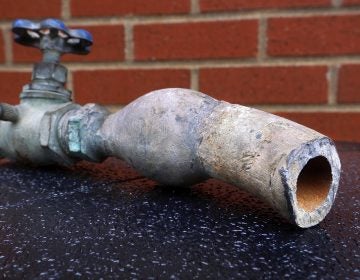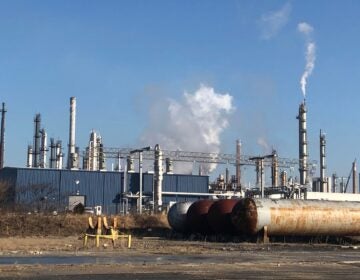New EPA soot standard could bring healthier air to parts of the Philly region
Officials predict Delaware County, Pa., and Camden County, N.J., will fail to meet the new standard without further action to reduce pollution.
Listen 1:14
Philadelphia, Wednesday, Oct. 27, 2021. (Matt Rourke/AP Photo)
This story is part of the WHYY News Climate Desk, bringing you news and solutions for our changing region.
From the Poconos to the Jersey Shore to the mouth of the Delaware Bay, what do you want to know about climate change? What would you like us to cover? Get in touch.
The federal government is cracking down on a ubiquitous but dangerous form of air pollution. It means parts of the Philly area could eventually breathe easier — but the impact of the change is likely years away.
“I want to emphasize how good this is,” said Kabindra Shakya, a professor at Villanova University who studies air pollution. “This [will help] us — and not only us, but future generations — to breathe better air. … This is one of the great incentives for us to … leave them with a better environment.”
This week, the EPA announced a new, stricter standard for soot, also known as fine particulate matter pollution. It lowers the concentration of allowable PM2.5 pollution in the ambient air by 25% — a change EPA predicts could prevent thousands of premature deaths in 2032.
The air in several Pennsylvania and New Jersey counties would fail the new standard if implemented now. But federal officials say the earliest states will likely need to prove compliance is 2032. By then, only a small handful of counties in the Philly region would need to lower pollution to meet the standard, EPA projections show.
Particulate matter comes from sources including car tires, tailpipes of diesel and gas-powered vehicles, wildfires or junkyard fires, and industrial facilities like trash incinerators or power plants.
The tiny particles — less than 2.5 microns in diameter, or a tiny fraction of the width of a human hair — can lodge deep inside the lungs and even enter the bloodstream. The particles can cause asthma attacks, heart attacks, and cancer.
The new air quality standard reflects a growing understanding of these health risks, Shakya said.
“Now we’re changing our definition of safety, which is based on more research that’s come out,” he said.
But Shakya notes the EPA’s new standard — an annual average concentration of 9 µg/m3 — is still much higher than the yearly average of 5 µg/m3 the World Health Organization considers safe.
In the U.S., people of color tend to be exposed to more particulate pollution than white people, regardless of income level.
In Philadelphia, Black and Hispanic children are hospitalized for asthma symptoms at much higher rates than White and Asian children. Childhood asthma hospitalizations are highest in lower Northeast, upper North, and West Philadelphia.
If states needed to comply immediately with the stricter standard announced this week, Camden County in New Jersey and Philadelphia, Delaware, Cambria, Dauphin, Lancaster, York, and Allegheny counties in Pennsylvania would fail, according to the EPA.
But the agency predicts the air will get cleaner by 2032 — the earliest states would likely need to prove compliance — thanks to pollution control strategies already in place, such as emissions standard for heavy-duty vehicles, a rule that aims to cut pollution from upwind power plants, and a recent regulation on methane leaks from oil and gas operations. By the compliance deadline, only Delaware and Allegheny counties in Pennsylvanian and Camden and Bergen counties in New Jersey should be in noncompliance, according to EPA projections.
Preliminary data shows that all counties in the state of Delaware would pass the new standard if implemented today, according to an EPA spokesperson.
States with counties that fail the standard must develop plans to reduce pollution. These could include actions such as tightening vehicle emissions inspections or requiring existing industrial facilities to install new pollution control devices to meet stricter state standards, said David Hess, who served as secretary of Pennsylvania’s Department of Environmental Protection in the early 2000s.
“Everything, essentially, would be on the table,” Hess said.
States try to reduce pollution in the most cost-effective ways they can, Hess said. So, environmental regulators in Pennsylvania and New Jersey will need to start by analyzing where fine particle pollution comes from.
“You’re looking at anything that deals with the combustion of fossil fuels, … everything from mining, quarries,” he said. “You’d have to look at all those sources, figure out where you’re going to get the biggest bang for the buck in terms of reductions.”
Once the EPA determines an area fails the new standard, that area must plan to meet the standard within six years. As soon as the rule goes into effect, companies applying for permits to become new major sources of pollution or to expand existing facilities must incorporate the new standards into their air quality analyses.
It’s unlikely that states would revoke permits for existing polluters, Hess said — but facilities could choose to shut down if new pollution standards are too costly to comply with.
Pennsylvania and New Jersey should convene stakeholder groups facilitated by an independent third party to advise this planning process, including representatives from polluting industries, environmental groups, municipal officials, and people affected by pollution, Hess said. This ensures there’s buy-in when state-level rules are put in place, he said.

Get daily updates from WHYY News!
WHYY is your source for fact-based, in-depth journalism and information. As a nonprofit organization, we rely on financial support from readers like you. Please give today.






